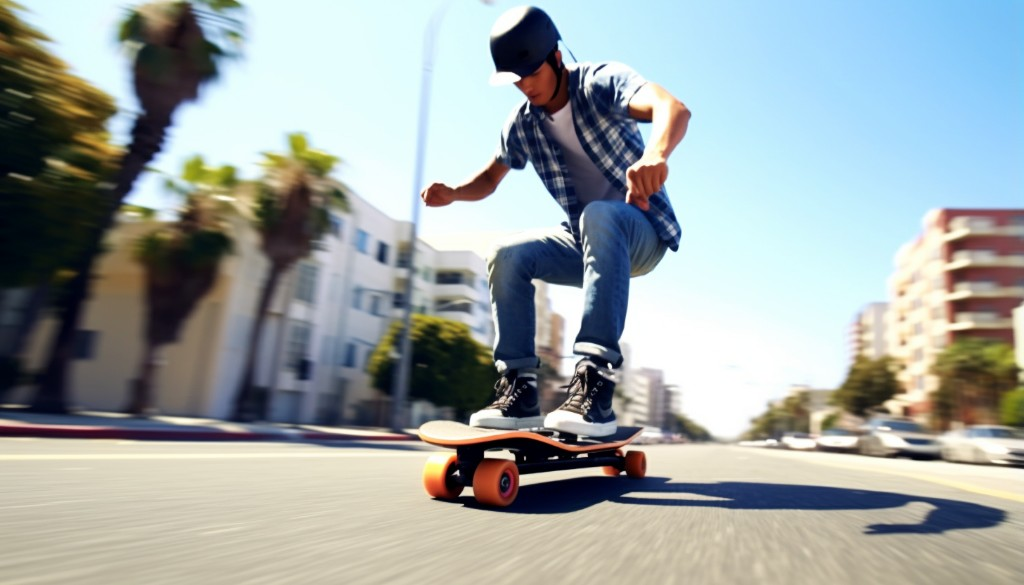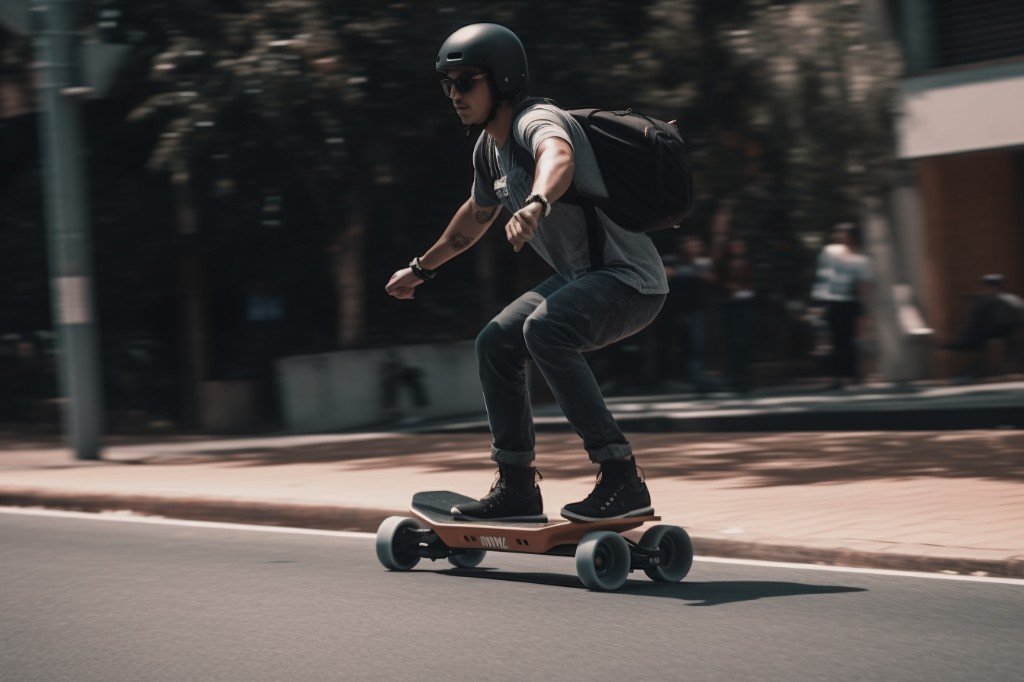As the popularity of electric skateboarding skyrockets, so does the importance of understanding its safety implications. This comprehensive analysis dives into the fascinating world of electric skateboarding, dissecting risk factors, exploring injury statistics, and underscoring effective safety practices. It will arm you with crucial knowledge about the necessary gear, the impact of traffic, weather, and technology on your ride, and the role of regulatory oversight in enhancing safety. From seasoned riders to those just stepping onto their first electric board, this article is a must-read.
What we’ll cover:
- The Rise of Electric Skateboarding
- Risks Involved
- Injury Statistics
- Safety Practices for Riders
- Essential Safety Gear
- Traffic’s Role in Accidents
- Weather’s Impact on Safety
- Technology and Safety
- The Role of Regulation
Let’s jump right in and uncover why knowing these safety statistics and reports can make a world of difference to your electric skateboarding experience!
Understanding the Popularity of Electric Skateboarding
Electric skateboarding is more than just a pastime; it has become a phenomenon that has taken the world of outdoor recreation by storm. The rise in popularity of this activity has been nothing short of meteoric.
But what is driving this trend? A quick glance at the demographic data provides some clues. Young adults, particularly males between the ages of 18 and 34, have embraced electric skateboarding in droves. The appeal of this mode of transport lies in its combination of technology, convenience, and exhilaration.
Several factors contribute to the popularity of electric skateboarding. For starters, it represents a blend of traditional skateboarding with the advancements of technology. Electric skateboards come equipped with battery-powered motors that allow riders to travel at speeds not achievable on conventional skateboards.

Moreover, electric skateboarding offers an eco-friendly alternative for travel. As more people become environmentally conscious, electric skateboards present a sustainable option for commuting or simply exploring the neighborhood.
Finally, there is an undeniable cool factor associated with electric skateboarding. The thrill of cruising down the street is as much a part of the experience as the skateboard itself.
Analyzing the Risk Factors
While electric skateboarding offers numerous benefits, it is essential to acknowledge and understand the associated risks. One primary risk factor is speed. Electric skateboards can reach impressive velocities that inexperienced riders may find challenging to control, leading to a phenomenon known as speed wobble.
A speed wobble occurs when a rider loses control due to high speed, causing the skateboard to wobble from side to side. This can easily lead to falls and injuries if not properly managed.
Riding beyond your skill level is another risk that electric skateboarders face. It’s crucial for riders to gradually build their skills and confidence before attempting more challenging maneuvers or navigating through heavy traffic.
Also, because electric skateboarding involves moving at high speeds on hard surfaces, there is always a risk of collision with vehicles, pedestrians, or fixed objects. Wearing appropriate protective gear and maintaining awareness of surroundings can help mitigate these risks.

Skateboarding Injuries: A Statistical Overview
Electric skateboard accidents and injuries can vary greatly in severity. Some riders suffer minor bruises or scrapes, while others sustain more serious injuries such as bone fractures or head injuries.
According to the U.S. Consumer Product Safety Commission, approximately 100,000 people visit emergency departments each year due to skateboard-related injuries. Of these, about a third involve head injuries, highlighting the importance of wearing helmets when riding.
Bone fractures are another common injury associated with skateboarding. Wrists, arms, and ankles are particularly vulnerable, often bearing the brunt of impact during falls.
When compared to other sports such as football or basketball, it’s clear that skateboarding carries its own unique set of risks and injury profiles. While every sport has potential hazards, awareness and preparation are key to reducing injury risk in electric skateboarding.
In light of these statistics, it’s imperative for riders to learn how to fall correctly and always wear protective gear such as helmets, knee pads, elbow pads, and wrist guards. Understanding how to manage speed and not riding beyond skill levels can also significantly reduce the likelihood of injury.

Reducing Risk: Safe Riding Techniques and Practices
Safety should always be a top priority when you’re riding an electric skateboard. From understanding the right techniques to being aware of potential hazards, there are several strategies you can apply to reduce your risks and ensure a safe ride.
Importance of Training
If you’re stepping on an electric skateboard for the first time, proper training is essential. It’s not just about learning how to balance and steer, but also about understanding the board’s controls and mechanisms. This helps to ensure that when you’re out on the road, you can confidently handle your board and react quickly to any situation that comes your way.
Right Riding Techniques
There are several techniques that can help you ride an electric skateboard safely. Mastering how to start and stop smoothly, how to carve turns without losing control, and how to maintain a steady speed are all crucial skills. These not only enhance your joy of skateboarding but also ensure you can safely ride in a variety of situations.
Moreover, it’s essential for skateboarders to ride within their abilities. Overestimating your skills and pushing beyond your limits can lead to accidents. Always be mindful of your capabilities and gradually build up your skills.
Avoiding Dangerous Situations
Aside from the riding techniques, being aware of your surroundings plays a key role in reducing risks. Always be on the lookout for potential hazards like potholes, puddles, or debris on the road surface. Remember, the smoother the surface, the less likely it is for you to lose control or fall off.

Crucial Safety Gear for Electric Skateboarding
Notwithstanding your skills or experience level, wearing safety gear is non-negotiable when you’re on an electric skateboard. The right protective equipment can drastically reduce the severity of injuries in case of a fall or collision.
Essential Safety Gear
When we talk about safety gear for skateboarding, the first thing that comes to mind is a bicycle helmet. It’s undoubtedly the most crucial piece of personal protective equipment. A helmet protects your head from severe injuries and should always be worn while skateboarding.
Protective gear also includes knee and elbow pads. These can cushion the impact if you take a tumble and help prevent cuts, scrapes, and other injuries. Another protective item worth considering is wrist guards. They can help you avoid fractures or sprains if you instinctively put your hands out when you fall.
Safety Gear Functions
Apart from physical protection, safety gear also serves other functions. For example, brightly colored or reflective gear can make you more visible to motorists, especially in low-light conditions. This is particularly important if you frequently ride near traffic.
Reducing Risk with Safety Gear
In essence, wearing the right safety gear doesn’t just protect you physically – it also gives you confidence, knowing that you’re protected in case something goes wrong. Remember, no matter how comfortable you feel on your board or how short your trip, always suit up with your safety gear.

Analyzing the Role of Traffic in Electric Skateboarding Accidents
Navigating through traffic on an electric skateboard can be quite challenging. However, understanding the common incidents involving traffic and adhering to traffic laws can significantly reduce the likelihood of accidents.
Incidents Involving Traffic
Collisions with vehicles are unfortunately common when skateboarding in areas with high traffic. These accidents often occur due to a lack of visibility, misjudgments of speed and distance, or failure to yield right of way.
Importance of Traffic Laws
Adhering to traffic laws is crucial when skateboarding on roads shared with motor vehicles. This might involve following road signs, signaling your intentions, yielding to pedestrians, or riding in designated lanes where available.
To stay safe among traffic, always assume that drivers cannot see you. Make eye contact with drivers at intersections to confirm they’ve seen you before you proceed.
Safe Riding in Traffic
Safe riding in traffic involves not just following laws but also practicing defensive riding strategies. Being proactive about your safety means continuously scanning your environment for potential hazards like potholes, drains or a pedestrian stepping onto the road unexpectedly.
By understanding and respecting traffic, as well as being conscious of road surface conditions, you can significantly minimize your risk of a traffic collision while enjoying your ride on an electric skateboard.

The Importance of Weather Conditions
Weather conditions, especially rain, can deeply affect the safety of any road user. But for those who use an electric skateboard, it’s an aspect that must not be overlooked. The level of impact that weather conditions can have on the safety and performance of an electric skateboard is significant.
Rain can affect the traction of the skateboard wheels on the road, leading to potential slips and accidents. On a wet road, the coefficient of friction reduces, making it harder for the wheels to grip the surface. This can result in loss of control, especially when making turns or braking suddenly. Hence, understanding the weather conditions before hitting the road is crucial for electric skateboard riders.
Besides affecting the grip, rain can also harm the electronic components of a skateboard. Electric skateboards are powered by batteries, and water can seep into them, affecting their functioning or even causing them to short circuit. This highlights the importance of having waterproof components and ensuring they are well-maintained to withstand rainy conditions.

Impact of Technology on Safety
In the realm of electric vehicles, technology has played a significant role in improving safety measures. This is particularly true in the case of electric skateboards. However, as with any technological advancement, it has its potential hazards.
The heart of an electric skateboard lies in its electric battery. The two most common types used are the lithium-ion battery and the lithium polymer battery. These batteries provide high power outputs necessary for the skateboard to run, but they also pose risks if not handled properly. For instance, overcharging or damage to these batteries could lead to overheating and, at worst, fire incidents.
But technology isn’t all about risks; it also brings plenty of safety advancements. For instance, some electric skateboards now come equipped with regenerative braking systems that recharge the battery while braking, a feature borrowed from other electric vehicles.
Likewise, advancements in remote control technology have improved the responsiveness between the rider’s input and the board’s actions. This reduces lag time and makes for swifter reactions in unexpected situations. Other cutting-edge features include smart LED lights that increase visibility and app integrations that allow for comprehensive monitoring and control.

Regulatory Oversight and its Importance
To ensure safety standards are met and maintained, regulatory oversight plays a critical role. One such body involved in this process is the U.S. Consumer Product Safety Commission. They set safety standards for various consumer products, including electric skateboards.
Regulatory bodies scrutinize the design and manufacturing process to ensure that high safety standards are met. They also play a crucial role in prompting recalls or modifications when necessary. Over the years, there have been incidents where certain models of electric skateboards were found to have defects posing serious safety risks. These instances triggered regulatory actions leading to product recalls or modifications.
These regulatory bodies’ roles are not just limited to taking actions post-incident. They also work proactively by setting stringent safety standards that manufacturers must adhere to before their products hit the market. This regulatory oversight ensures that only products that meet high safety standards are available to consumers.
The important role of regulatory oversight underscores the need for consumers to purchase products from companies that adhere to these regulations. It’s a key factor that contributes to safe and enjoyable electric skateboarding experiences.

Closing Thoughts
The rise in popularity of electric skateboarding is palpable, driven by the thrill it offers and its convenience as a mode of transport. However, this comes with notable risk factors and an increase in skateboarding injuries, as supported by the statistical overview. This makes it crucial for riders to understand safe riding techniques and practices, effectively reducing the risk of accidents. Alongside safe practices, the use of crucial safety gear further enhances safety in electric skateboarding. We also can’t overlook the role of traffic in electric skateboard accidents, indicating the need for riders to be cautious in traffic-filled areas. Similarly, weather conditions play a significant part, making it essential to understand its importance and impact on safety. The positive impact of technology cannot be overstated, with advancements contributing significantly to safety improvements. Taking note of the safety information contained within this article will arm you with the knowledge to ride your electric skateboard safely, without compromising the fun factor!
Frequently Asked Questions
What is the most common injury in electric skateboarding?
The most common injury in electric skateboarding is often a fracture or sprain, usually occurring to the arms or wrists as riders instinctively try to break their fall using their hands.
How can I reduce the risk of accidents while using an electric skateboard?
You can reduce the risk of accidents while using an electric skateboard by adhering to safe riding techniques and practices. This includes respecting traffic rules, being aware of your surroundings, and adjusting your riding style based on weather conditions.
What safety gear is essential for electric skateboarding?
Essential safety gear for electric skateboarding includes a helmet to protect your head from impact injuries, knee and elbow pads to protect against fractures or sprains, wrist guards to prevent wrist injuries, and closed-toe shoes for foot protection.
How do weather conditions affect the safety of electric skateboarding?
Weather conditions can significantly affect the safety of electric skateboarding. For instance, wet or icy conditions can make surfaces slippery, reducing traction and increasing the risk of falls and accidents. High winds can also make it challenging to maintain control of the board.
What role does technology play in enhancing the safety of electric skateboards?
Technology plays a significant role in enhancing the safety of electric skateboards. This includes developments in braking systems, improved board stability, integrated lighting for better visibility, and remote controls that allow for better board control.
